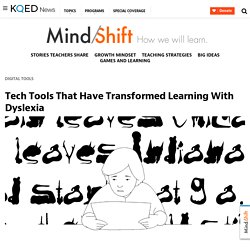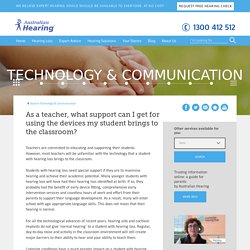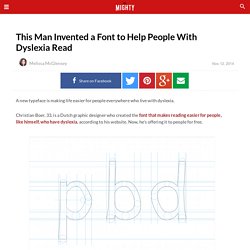

100225 The Adaptive Dimension. Tech Tools That Have Transformed Learning With Dyslexia. Fifth-grade teacher Kyle Redford remembers with emotion the day she unwittingly put an iPad in the hands of one of her 10-year-old dyslexic students, a day she called “a complete game changer.”

While the rest of the class was working in a writers workshop, she handed the student an iPad and told him to try and experiment with its speech-to-text feature. With minimal expectations, Redford figured that the newness and the boy’s curiosity would at least keep him busy during writing time, which he usually found frustrating. While Redford described the boy as “very bright,” he “couldn’t even compose a sentence to save his life” because of his dyslexia. Any classroom assignment having to do with writing made him moody. So, as Redford guided the rest of the class through the workshop, the student stepped outside the classroom and spoke his ideas for his writing assignment into the iPad. At first, it was difficult. The Rise of Technology Helpful Tech Tools. 15309 Adaptive Dimension. Your Child's Communication Development. For Parents of Children with Hearing loss. Ministry of Education - Special Programs: Hearing Impairments. OSLA - Central Auditory Processing.
Auditory Processing can be understood as the link between the ears and the brain.

Both children and adults can be affected by difficulties understanding what is heard, despite normal hearing and normal intelligence. This difficulty impacts the ability of the child or adult to function in everyday life. Our ears detect sound; the brain gives these sounds meaning An auditory processing disorder (APD) is a disruption of sound along the pathway from the ear to the brain, which interferes with understanding.
The ears do not work alone to decipher incoming information- the brain has its own part to play. A Team of Professionals Must be Involved in the Diagnosis Signs of an Auditory Processing Disorder Who can be tested for APD? Almost any child aged 7 or older can be tested for APD. What will my child be expected to do? The tests for APD simply seek to discover what a child hears when sounds enter the auditory system. Therapy There is no “one size fits all” therapy approach. Next Steps. As a teacher, what support can I get for using the devices my student brings to the classroom?
Teachers are committed to educating and supporting their students.

However, most teachers will be unfamiliar with the technology that a student with hearing loss brings to the classroom. Students with hearing loss need special support if they are to maximise hearing and achieve their academic potential. Many younger students with hearing loss will have had their hearing loss identified at birth. If so, they probably had the benefit of early device fitting, comprehensive early intervention services and countless hours of work and effort from their parents to support their language development. As a result, many will enter school with age-appropriate language skills. For all the technological advances of recent years, hearing aids and cochlear implants do not give ‘normal hearing’ to a student with hearing loss. Listening conditions have a much greater impact on a student with hearing loss than on other students. How does remote microphone technology work? Some helpful features. Personal Program Plans - Publications Centre.
40252 PPP SORs. This Man Invented a Font to Help People With Dyslexia Read. A new typeface is making life easier for people everywhere who live with dyslexia.

Christian Boer, 33, is a Dutch graphic designer who created the font that makes reading easier for people, like himself, who have dyslexia, according to his website. Now, he’s offering it to people for free. The typeface is called “Dyslexie,” and Boer first developed it as a final thesis project when he was a student at the Utrecht Art Academy in the Netherlands. The font makes reading easier for people with dyslexia by varying the letter shapes more, making it harder to confuse similarly shaped letters like “b” and “d,” for example. Dyslexia is a language-based processing disorder resulting in a learning disability often characterized by difficulties with accurate word recognition, decoding and spelling, according to the National Center for Learning Disabilities. Research suggests that about 17 percent of the population has dyslexia, according to PBS. We face disabilities and diseases together. 5. Pre-assessment Ideas - Differentiation & LR Information for SAS Teachers.
“Assessment is today’s means of modifying tomorrow’s instruction.”

Carol Ann Tomlinson Pre-assessment provides valuable information about what is already known about a topic and readiness to start new instruction. Discovering prior knowledge allows the teacher to present new information at an appropriate level for the students. This process should continue throughout the learning process, so lessons can be adjusted according to student need. Listed below are some methods to pre-assess. Here are some other pre-assessment methods to consider: The Expert (Short Comedy Sketch)